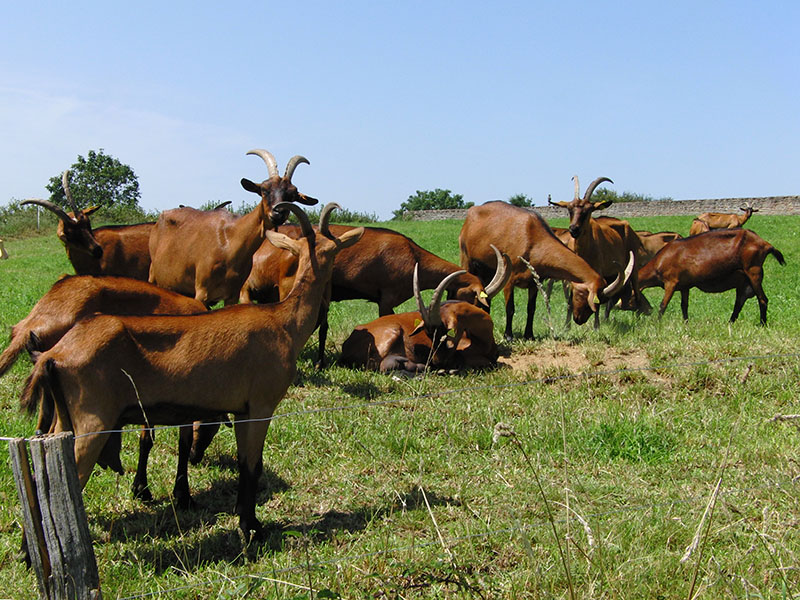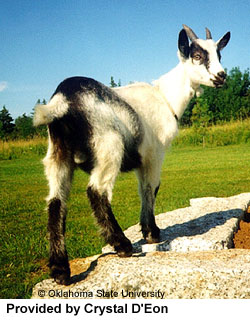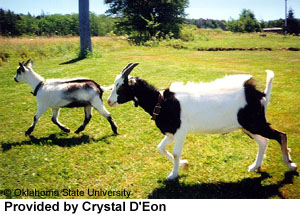Alpine Goats
T he French-Alpine is a breed of goat that originated in the Alps. The goats of Alpine
breed that were brought to the United States from France where they had been selected
for much greater uniformity, size, and production than was true of the goats that
were taken from Switzerland to France.
he French-Alpine is a breed of goat that originated in the Alps. The goats of Alpine
breed that were brought to the United States from France where they had been selected
for much greater uniformity, size, and production than was true of the goats that
were taken from Switzerland to France.
Size and production rather than color pattern have been stressed in the development of the French-Alpine. No distinct color has been established, and it may range from pure white through shades of fawn, gray, brown, black, red, bluff, piebald, or various shadings or combinations of these colors. Both sexes are generally short haired, but bucks usually have a roach of long hair along the spine. The beard of males is also quite pronounced. The ears in the Alpine should be of medium size, fine textured, and preferably erect.
 The French-Alpine is a larger and more rangy goat and more variable in size than are
the Swiss breeds. Mature females should stand not less than 30 inches at the withers
and should weigh not less than 135 pounds. Males should stand from 34 to 40 inches
at the withers and should weigh not less than 170 pounds. French-Alpine females are
excellent milkers and usually have large, well-shaped udders with well-placed teats
of desirable shape.
The French-Alpine is a larger and more rangy goat and more variable in size than are
the Swiss breeds. Mature females should stand not less than 30 inches at the withers
and should weigh not less than 135 pounds. Males should stand from 34 to 40 inches
at the withers and should weigh not less than 170 pounds. French-Alpine females are
excellent milkers and usually have large, well-shaped udders with well-placed teats
of desirable shape.
The French-alpine is also referred to as the Alpine Dairy goat and registration papers for this dairy goat use both designations and they are synonymous. These are hardy, adaptable animals that thrive in any climate while maintaining good health and excellent production. The face is straight. A roman nose, Toggenburg color and markings, or all-white is discriminated against. Alpine colors are described by using the following terms:
- Cou Blanc - (coo blanc) literally "white neck" - white front quarters and black hindquarters with black or gray markings on the head.
- Cou Clair - (coo clair) Literally "clear neck" - front quarters are tan, saffron, off-white, or shading to gray with black hindquarters.
- Cou Noir (coo nwah) literally "black neck" - Black front quarters and white hindquarters.
- Sundgau - (sundgow) black with white markings such as underbody, facial stripes, etc.
- Pied - spotted or mottled.
 Chamoisee - (shamwahzay) brown or bay - characteristic markings are black face, dorsal
stripe, feet and legs and sometimes a martingale running over the withers and down
to the chest. Spelling for male is chamoise.
Chamoisee - (shamwahzay) brown or bay - characteristic markings are black face, dorsal
stripe, feet and legs and sometimes a martingale running over the withers and down
to the chest. Spelling for male is chamoise.- Two-tone Chamoisee - light front quarters with brown or grey hindquarters. This is not a cou blanc or cou clair as these terms are reserved for animals with black hindquarters.
- Broken Chamoisee - a solid chamoisee broken with another color by being banded or splashed, etc.
- Any variation in the above patterns broken with white should be described as a broken pattern such as a broken cou blanc
Registries and Breed Associations
Canada
PO Box 31084 Willow West
Guelph, Ontario, N1H 8K1
United States
American Dairy Goat Association
PO Box 865
Spindale, NC 28160
Phone: (704) 286-3801
References
Briggs, Hilton M and D.M. Briggs. 1980. Modern Breeds of Livestock. Forth Edition, MacMillan Company
American Dairy Goat Association, PO Box 865, Spindale, NC 28160.
Phone: (704) 286-3801
